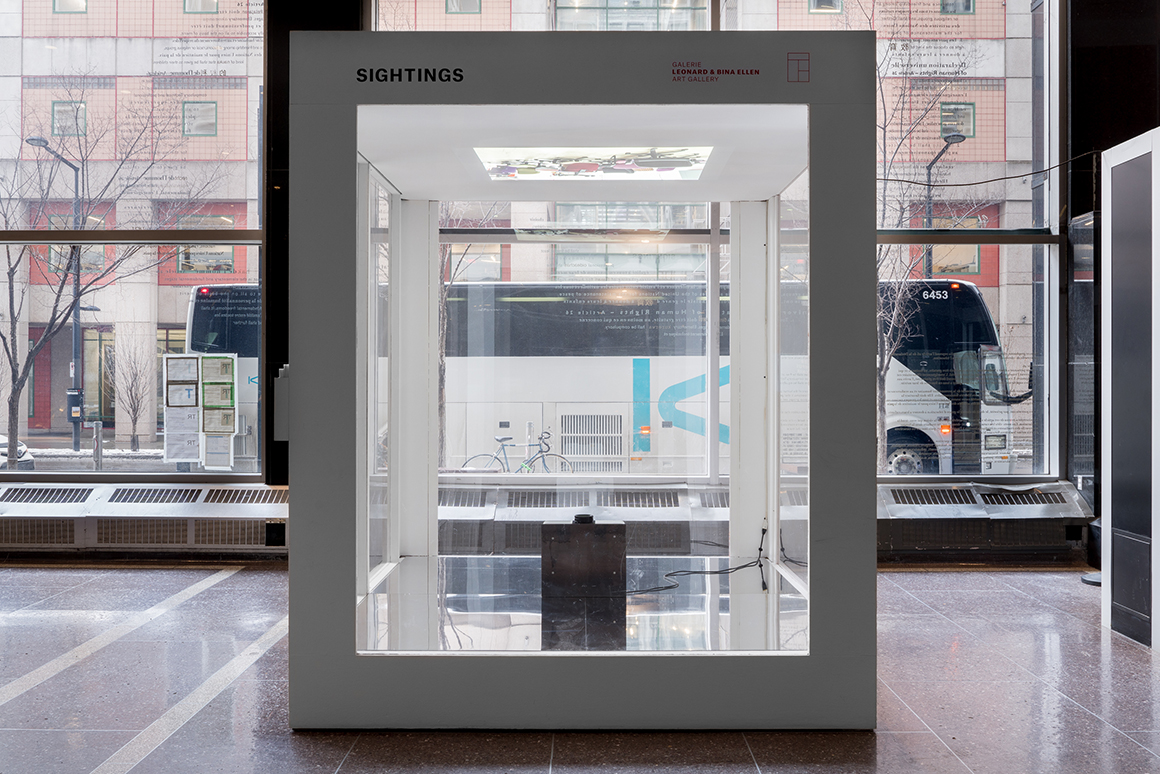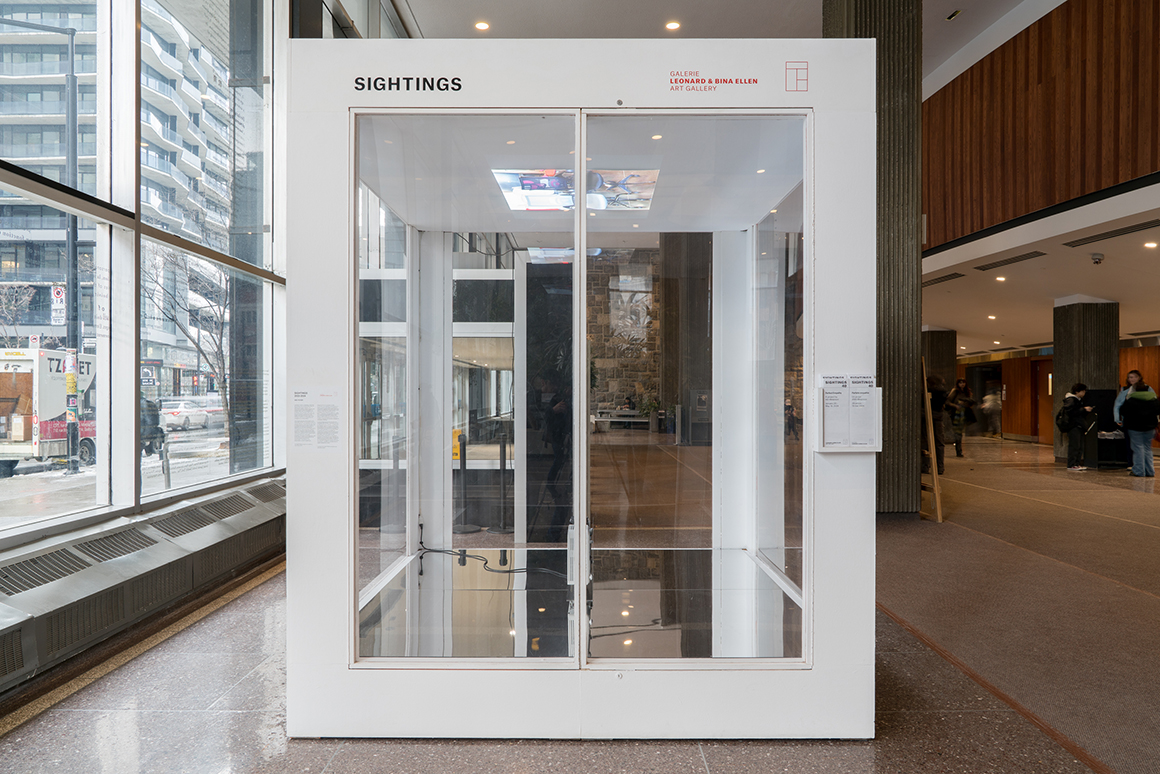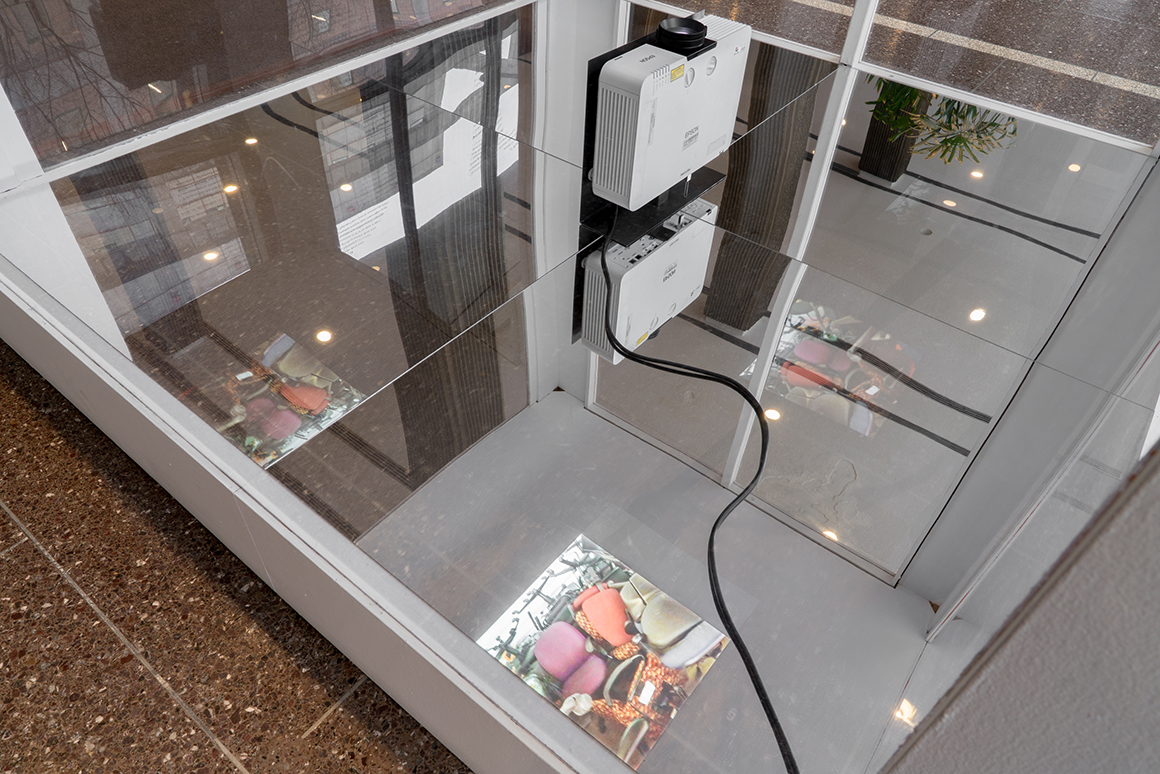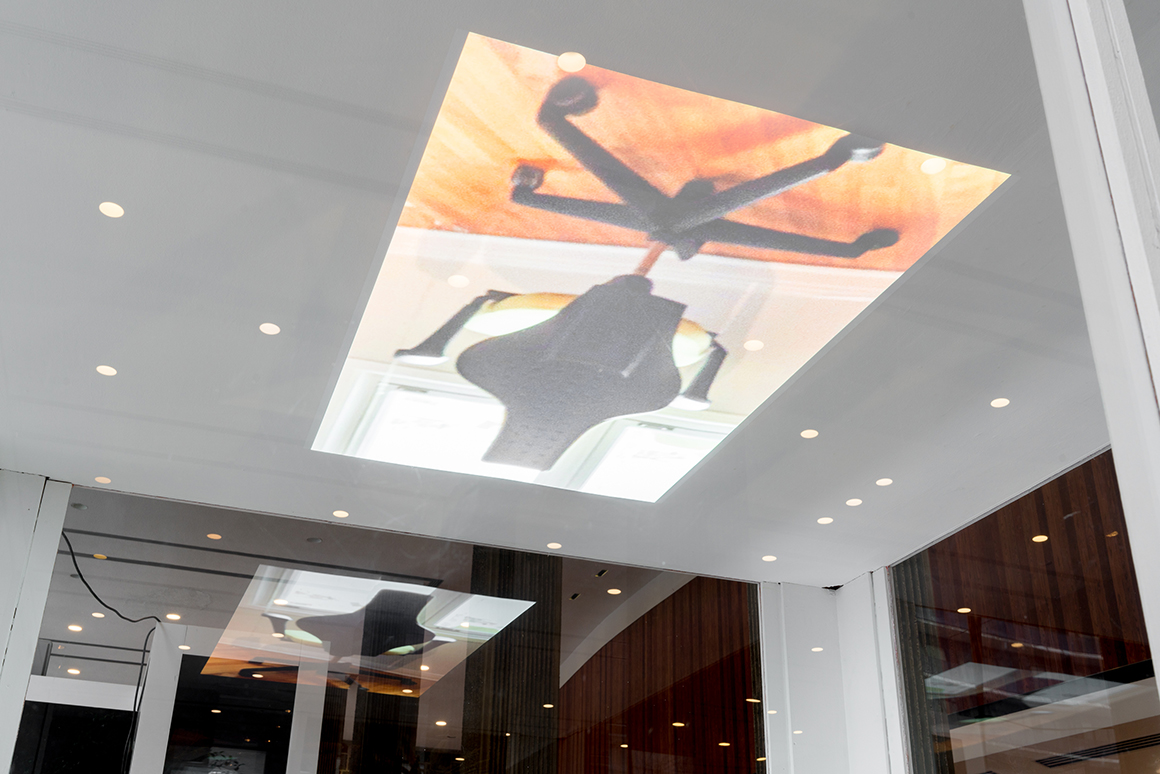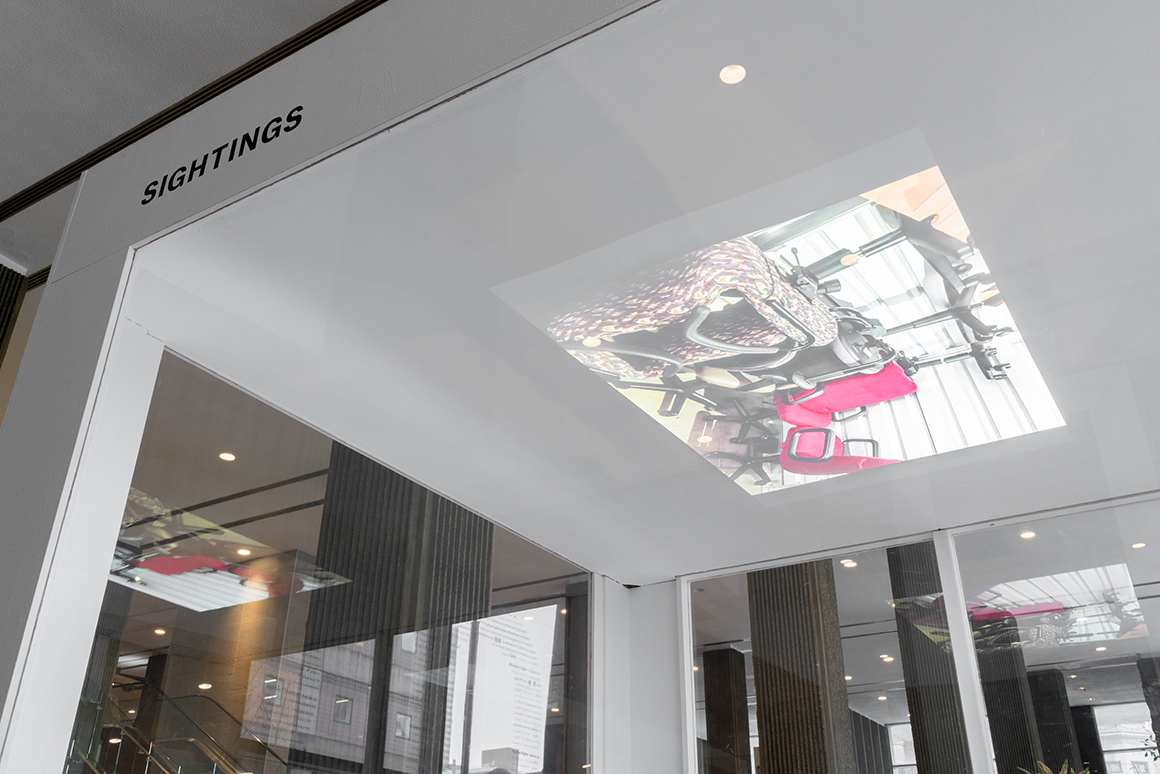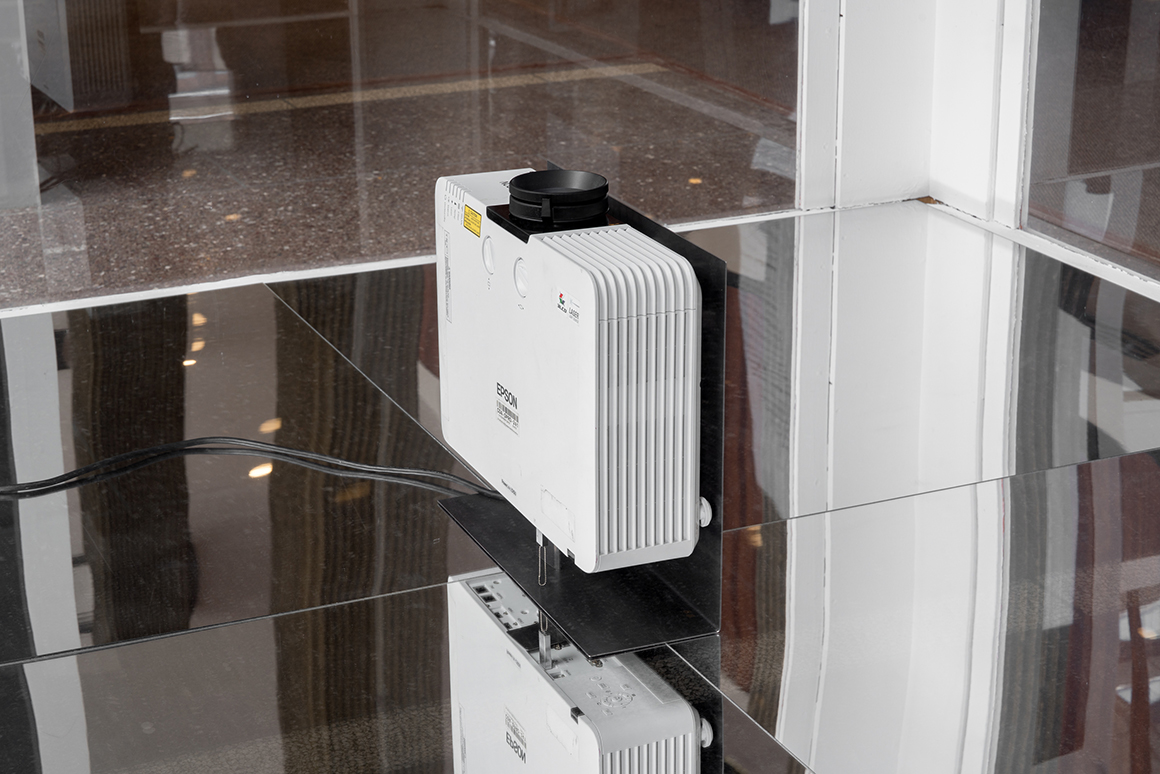SIGHTINGS 2022-2024
SEE FEVER
Launched in 2012 in celebration of the 50th anniversary of the Leonard & Bina Ellen Art Gallery’s Permanent Collection, the SIGHTINGS satellite exhibition program was conceived as an experimental platform to critically reflect upon the possibilities and limitations of the modernist “white cube.” As part of this program, artists and curators are invited to develop projects for a cubic display unit located in a public space at the university, with the aim of generating new strategies for art dissemination.
This fall, the Gallery launches a multi-year cycle focusing on the theme SEE FEVER. The expression refers to a fervent desire to “see everything,” the lure of strategies that aim to see “more” or “further,” and to contexts that widen our field of vision or destabilize our perceptual mechanisms. Reflecting this theme, the SIGHTINGS cube is envisaged as a raised observation platform whose four transparent walls provide a 360-degree view. Projects will examine the viewing subject’s perceptual and psychic experience when presented with a wide-angle perspective, the search for the panoramic view and the horizon, and the optical apparatuses and technologies that permit the augmentation, enhancement, and disorientation of vision’s spatial logic.
SIGHTINGS is located on the ground floor of the Hall Building: 1455, blvd. De Maisonneuve West and is accessible weekdays and weekends from 7 am to 11 pm. The program is developed by Julia Eilers Smith.
Perfect Empathy
Perfect Empathy is a 116-day projection-based installation that reflects upon itself. A long and slow slideshow of doubled images rotates within the cube, fluctuating in intensity depending on the environmental light conditions of its location. Beginning during the short and dark days of January, the projected images gradually fade with increasing sunlight moving into spring.
Melanson’s work frequently employs doubling, mirroring and disorientation to bring attention to blurred thresholds between bodies, objects and space. Perfect Empathy mimics the desire for and frustration of that which lies just beyond our grasp, as the scope and duration of the work make it nearly impossible to seize as a whole.
In the cube, a reflecting apparatus showcases images of ergonomic chairs in liminal spaces, alternating at irregular intervals. Melanson engages in associative meaning-making with found everyday objects and imagery, here featuring a large collection of images of office chairs in a state of suspension, waiting to be claimed. Their shapes anticipate usage by a body, all while determining the type of work said body might engage in while occupying them.
0:00
hey
0:04
is it campus
0:37
friend said maybe we should take a look
0:40
coming here I come here and very often
0:45
because it’s on my way coming back to
0:49
from work and I came here to do some
0:54
drawing and to do body drawing because
0:58
the muscle man’s muscle
1:03
the woman’s muscles are just so so so
1:10
expressive man hold on
see the difference in it
1:54
passion full of joy full of anger and
1:59
you just feel that he is the man
2:03
living his life to the fullest
2:06
experienced or he experienced his life
2:10
with a full emotion
2:22
the desire the anger the fight
2:29
it’s just so expressive when you
2:35
you want to do some drawings and figure
2:37
drawing come here and see
2:50
exaggerating but it’s it it
2:58
magnifies the strength of the human body it
3:02
just puts everything on full display
5:00
a thousand times and you realize
5:11
all you can do is attach yourself to a
5:16
person for life
5:20
intelligence intuition and feeling
5:28
change rewarding age and experience you
5:34
don’t outgrow the gates you grow into
5:39
them
5:46
I have never thought about it in such a way
5:50
every time I was coming
5:56
here and I felt I am at a loss and I could
6:02
not connect I could not connect myself
6:05
so much into it but if you if you put
6:12
away the fear and just stand here
6:19
often times we see art we feel it is
6:23
different or we feel the distance
6:26
between ourselves and the artwork
6:31
how about you get away and push away that
6:35
fear and just imagine that this
6:40
is for you it’s right in front of you
6:44
for you to walk in and walk through
7:01
the struggle one day they defied the
7:07
struggle
7:13
they suffer for the aim of finding
7:20
the universal truth or to find tools
7:26
To find something of their own expression
7:31
don’t be afraid of art it is here for you
7:38
we all go through it
7:45
I do not know the
7:54
work but I just let my imagination
7:59
and my thoughts run from
8:04
earth babies still attached to mama and
8:10
start to climb up and climb climb until
8:14
they become a doubt and they make their
8:17
own case their own new generation
8:34
defined through all these
8:37
difficulties and all these tortures on
8:43
cue
8:47
until the other is love there are so many
8:53
emotions in this the love of
8:59
men and women and the sacrifice
9:08
struggling so many things I do not
9:13
understand I do not understand the
9:15
language but definitely what you can
9:20
see is the struggle I remember i have
9:42
A different struggle
9:56
look to enjoy and see them it’s so
10:03
expressive for this body just imagine
3:08
such a wonderful wonderful piece of work
4:00
and yet when it comes to
4:15
The inevitable dismay over the inadequacy of
4:20
one’s own language and culture to share
4:25
revelations I have seen
4:39
they never they never fail to impress
4:43
look at them in the rain or when a
4:48
winter sun is low they take a different
4:52
quality of light then at night from below
10:31
I did come sometimes at sunset and when
10:37
when it is time of sunset this
10:40
place usually does not have
10:43
anybody here a
10:49
solemn and sacred place maybe I will
10:53
come in the evening again and do some
10:59
reading about this earth
11:04
hell but no matter how I understand it
11:13
how limited my knowledge about it it’s a
11:18
very impressive and powerful piece of
11:22
art and before I know before I learn
11:27
about it I have more freedom to sing it
11:30
in my own way that’s the good thing
11:33
about seeing sometimes you see art
11:37
and you see the explanation it helps
11:44
you to understand but on the other hand
11:47
it kind of blocks your imagination or
11:53
your singing is guided how about
11:57
just looking at a piece of work and use
12:01
your own brain use your own imagination
12:05
use your own logic to see
12:43
go to a museum just look at it and
12:49
think yourself do not be guided by others
12:54
be an independent thinker do you hear me
13:00
I’m sorry I do not know if the sound is
13:05
is okay or not but I enjoy a morning
13:13
like this I think I will do more I think
13:19
I will come here more often it’s it’s
13:23
very inspiring
13:27
at least looking at beautiful
13:32
things looking at nature and looking at
13:38
human effort in trying to make the world
13:42
into the place to make the place into
13:46
something that pleases us that makes us
13:52
think is a very very very
14:01
it’s a very very nice place a powerful
14:07
place for thought
Perfect Empathy is a 116-day projection-based installation that reflects upon itself. A long and slow slideshow of doubled images rotates within the cube, fluctuating in intensity depending on the environmental light conditions of its location. Beginning during the short and dark days of January, the projected images gradually fade with increasing sunlight moving into spring.
Melanson’s work frequently employs doubling, mirroring and disorientation to bring attention to blurred thresholds between bodies, objects and space. Perfect Empathy mimics the desire for and frustration of that which lies just beyond our grasp, as the scope and duration of the work make it nearly impossible to seize as a whole.
In the cube, a reflecting apparatus showcases images of ergonomic chairs in liminal spaces, alternating at irregular intervals. Melanson engages in associative meaning-making with found everyday objects and imagery, here featuring a large collection of images of office chairs in a state of suspension, waiting to be claimed. Their shapes anticipate usage by a body, all while determining the type of work said body might engage in while occupying them.
Alli Melanson lives and works in Tiohtià:ke (Montréal). She holds an MFA from Concordia University and a BFA from OCAD University. In 2023, she presented solo exhibitions at Joe Project, Chris Andrews and 100 Bell Towers, and was included in group shows at Franz Kaka and the Leonard & Bina Ellen Art Gallery.
The artist wishes to thank Julia Eilers Smith, Hugues Dugas, Andrew Hoekstra and Paras Vijan.







